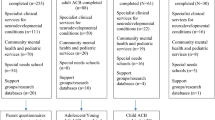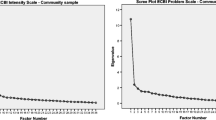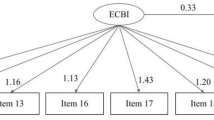Abstract
The purpose of the present study was to develop the Toddler Behavior Screening Inventory (TBSI) for rapidly assessing maternal reports of toddler behavior problems. The TBSI is a 40-item measure intended for use by pediatricians, psychologists, and other child-care professionals. A group of mothers (n = 312) rated the initial 93-item TBSI in terms of behavior frequency and parental perception of the behavior as problematic. Following item elimination, 40 items were retained due to being both frequent and problematic at all toddler age levels. Data were obtained with a new sample of mothers (n = 581) and showed the TBSI to possess good reliability and validity.
Similar content being viewed by others
REFERENCES
Achenbach, T. M., Edelbrock, C., & Howell, C. T. (1987). Empirically based assessment of the behavioral/emotional problems of 2-and 3-year-old children. Journal of Abnormal Child Psychology, 15, 629–650.
Beautrais, A. L., Fergusson, B. A., & Shannon, F. T. (1982). Family life events and behavior problems in preschool aged children. Pediatrics, 70, 774–779.
Behr, L., & Stringfield, S. (1974). A behavior rating scale for the preschool child. Developmental Psychology, 10, 601–610.
Bennett, F. C., & Guralnick, M. J. (1991). Effectiveness of developmental intervention in the first five years of life. Pediatric Clinics of North America, 38, 1513–1528.
Campbell, S. B., Ewing, L. J., Breaux, A. M., & Szumowski, E. K. (1986). Parent-referred problem three-year-olds: Follow-up at school entry. Journal of Child Psychology and Psychiatry, 27, 473–488.
Chamberlin, R. W. (1982). Prevention of behavioral problems in young children. Pediatric Clinics of North America, 29, 239–247.
Christophersen, E. R. (1986a). Anticipatory guidance on discipline. Pediatric Clinics of North America, 33, 789–798.
Christophersen, E. R. (1986b). Behavioral screening. In E. Charney (Ed.), Well-child care (pp. 37–43). Report of the Seventeenth Ross Roundtable on Critical Approaches to Common Pediatric Problems. Columbus: OH: Ross Laboratories.
Christophersen, E. R. (1991). Common behavior problems and the pediatrician. Pediatric Annals, 20, 227.
Cummings, E. M., & Davies, P. T. (1994). Maternal depression and child development. Journal of Child Psychology and Psychiatry, 35, 73–112.
Drell, M. (1992). A multimodal treatment strategy of behavior problems in toddlers. Infant Mental Health Journal, 13, 231–244.
Dumas, J. E. & Wahler, R. G. (1983). Predictors of treatment outcome in parent training: Mother insularity and socioeconomic disadvantage. Behavioral Assessment, 5, 301–313.
Education of Handicapped Act Amendments, PL 99-457, United States, 1986.
Esser, Schmidt, & Woernner (1990). Epidemiology and course of psychiatric disorders in school age children—Results of a longitudinal study. Journal of Psychological and Psychiatric Discipline, 31, 243–263.
Eyberg, S. M., & Ross, A. W. (1978). Assessment of child behavior problems: The validation of a new inventory. Journal of Clinical Child Psychology, 7, 113–116.
Howard, B. J. (1991). Discipline in early childhood. Pediatric Clinics of North America, 38, 1351–1369.
Ireton, H. (1990). Developmental screening measures. In J. H. Johnson & J. Goldman (Eds.), Developmental assessment in clinical child psychology (pp. 78–99). New York: Pergamon Press.
Johnston, C., & Pelham, W. E. (1990). Maternal characteristics, ratings of child behavior, and mother-child interactions in families of children with externalizing disorders. Journal of Abnormal Child Psychology, 18, 407–417.
Kemper, K. J. (1992). Self-administered questionnaire for structured psychosocial screening in pediatrics. Pediatrics, 89, 433–436.
Miller, S., & Scarr, S. (1989). Diagnosis of behavior problems in two-year-olds. Journal of Clinical Child Psychology, 18, 290–298.
Prior, M., Smart, D., Sanson, A., Pedlow, R., & Oberklaid, F. (1992). Transient versus stable behavior problems in a normative sample: Infancy to school age. Journal of Pediatric Psychology, 17, 423–443.
Richman, N. (1977). Is a behavior checklist for preschool useful? In Epidemiological approaches to child psychiatry (pp. 125–136). London: Academic Press.
Wahler, R. G. (1980). The insular mother Her problems in parent-child treatment. Journal of Applied Behavior Analysis, 13, 207–219.
Webster-Stratton, C. (1990). Long-term follow-up of families with young conduct problem children: From preschool to grade school. Journal of Clinical Child Psychology, 19, 144–149.
Author information
Authors and Affiliations
Rights and permissions
About this article
Cite this article
Mouton-Simien, P., McCain, A.P. & Kelley, M.L. The Development of the Toddler Behavior Screening Inventory. J Abnorm Child Psychol 25, 59–64 (1997). https://doi.org/10.1023/A:1025759408417
Issue Date:
DOI: https://doi.org/10.1023/A:1025759408417




